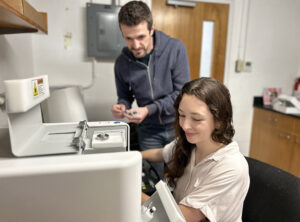Ground Truthing for NASA – ASU BIOS Selected to Validate Satellite Measurements of Plankton and Ocean Illuminance

NASA awarded ASU BIOS grants to lead two research teams involved in the PACE validation process. Over three annual cycles, Associate Scientists Amy Maas and Leo Blanco-Bercial will lead research focused on counting and characterizing plankton that comprise the ocean surface, while Senior Scientist Eric Hochberg’s project involves measuring light entering and leaving the ocean surface. Assistant Scientist Rod Johnson serves as co-investigator on both projects, integrating the PACE work into the broader BATS efforts.
Typically associated with the study of Earth’s upper atmosphere and beyond, satellites deployed by the National Aeronautics and Space Administration (NASA) also augment our understanding of Earth’s ecosystems, including critical information about the ocean such as locations of algal blooms and levels of marine photosynthesis.
While collecting these data is vital to advancing society’s grasp of the planet’s health and resilience to climate change, scientists rely on corresponding research here on Earth to validate the accuracy of findings gathered from space. Two teams of ASU BIOS researchers will fill that ground truthing role for NASA’s new Plankton, Aerosol, Cloud ocean Ecosystem (PACE) satellite mission, that launched from the Kennedy Space Center in Florida earlier this month.
An outcome of the National Academies of Sciences, Engineering and Medicine’s (NASEM) Decadal Surveys dating back to 2007, the current PACE mission is part of NASA’s implementation of NASEM’s 2018 report, “Thriving on Our Changing Planet: A Decadal Strategy for Earth Observations from Space.” The mission is designed to improve understanding of how the ocean and atmosphere exchange carbon dioxide and measure key atmospheric variables associated with air quality and Earth's climate. It will also increase knowledge about the effect of climate change on blooms of ocean phytoplankton, as well as how particles such as dust and smoke can influence cloud formation and the warming and cooling of the planet.”
PACE will provide measurements enabling prediction of “boom-bust” cycles of fisheries, appearance of harmful algae, and other factors that affect commercial and recreational industries. The mission also supports the Biden Administration’s Ocean Policy Committee Ocean Climate Plan priorities and addresses marine sustainability concerns identified by the World Resources Institute and United Nations.
Late last year, NASA awarded ASU BIOS grants to lead two research teams involved in the PACE validation process. Over three annual cycles, Associate Scientists Amy Maas and Leo Blanco-Bercial will lead research focused on counting and characterizing plankton that comprise the ocean surface, while Senior Scientist Eric Hochberg’s project involves measuring light entering and leaving the ocean surface. Assistant Scientist Rod Johnson will serve as co-investigator (co-PI) on both projects, integrating the PACE work into ASU BIOS’s broader Bermuda Atlantic Time-series Study (BATS) efforts.
“This work is both exciting and incredibly important because it allows us to ensure that our new measurements and old measurements are directly comparable,” Maas said. “At the same time, it is using new and improved technology – broadband light measurements from the satellite and a modern flow-through microscopic instrument that takes high speed images of individual phytoplankton, which combined will give us new, more detailed insight into the abundance and diversity of the tiny microorganisms that support life on this planet.”

The FlowCam, used by marine ecologists, Lauren Kittell-Porter and Leo Blanco Bercial, helps analyze plankton species and abundance, offering valuable insights in characterizing plankton that comprise the ocean surface.
PACE will use two primary tools during its mission: the ocean color instrument - a spectrometer to measure intensity of light over portions of the electromagnetic spectrum; and multi-angle polarimeters - radiometers that measure how the oscillation of sunlight within a geometric plane is changed by passing through clouds, aerosols and the ocean. Together, these instruments will enable new opportunities to monitor and respond to ecosystem changes and ways in which the atmosphere and ocean interact.
“Apart from the obvious excitement related to the PACE program, I am really looking forward to getting the data from the new instruments. The information that could provide has not been collected at BATS on a regular basis,” Blanco-Bercial said. “We will be able to get several years of these measurements, which will merge the gap between two of the main plankton-related outputs from the program. Measuring phytoplankton, but also some non-photosynthetic components of the community that have been historically neglected, it is for me an unexplored treasure with immense potential.”
Hochberg’s project comprises the first step of BIOS’s work: validation of radiometry in the first three years of PACE (2024-2027). Step two, led by Maas and Blanco-Bercial and running from 2025 through 2028, will validate PACE’s ocean color-derived products.
Although the ground truthing process won’t likely begin for several months, instruments are already at work at sea to ensure protocols are reliable and in place when the project starts. In addition, the four PIs are collaborating with NASA from the start. A PI kickoff meeting is planned for the first week of March 2024, about a month after the PACE satellite launch.
